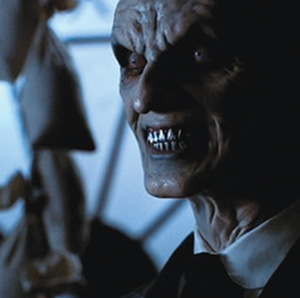

The slightly off-Masterpiece Theater voice of the Watcher Rupert Giles (Anthony Stewart Head): “Previously, on Buffy the Vampire Slayer” and the thundering surf theme song by Nerf Herder—the justly beloved cult show is available for a good long downloadable binge-watch on Hulu Plus.
Gallant Buffy (Sarah Michelle Gellar), an ex-cheerleader from suburban Sunnydale, is the Chosen One: humanity’s last line of defense against demonic annihilation. She certainly had her hands full. She died and was resurrected twice. She fought the schizophrenic Goddess Glorificus (Clare Kramer), the Robert Mitchum-like evil preacher Caleb (Nathan Fillion), the mean-girl rogue slayer Faith (Eliza Dushku), and David Lynch himself—well, almost himself, a Boy Scout-like Mayor (Harry Groener) readying himself for a dread Ascension.
Buffy was created by Joss Whedon, later of The Avengers and Much Ado About Nothing. He gained his rep here for the shocking switch, for “Whedoning” (killing a character with a gasp-inducing swiftness), for wildly pomo referencing. “Buffy” and “Giles” were names from the ’60s sitcom Family Affair, a sort of early argument for alternative families. Buffy continued this argument, resoundingly.
Whedon ambitiously tried to emulate cinema on a TV budget. The mostly silent “Hush” episode is required Halloween viewing. Maybe even better is “I Only Have Eyes for You” about a haunting, scored to the Flamingos’ terrifyingly lovely doo-wop ballad. My all time fave: “Anne,” in which Buffy (described after one of her deaths as “the warrior of the people”) harrows a privatized Hell, a demon-run sweatshop. She liberates it with hammer and sickle: a rousing pop-Marx moment.
Unlike Bella Swan, Buffy was no lip-chewing virgin. Her great love was the studly but dull vampire-with-a-soul Angel (David Boreanaz), who had his own spinoff show. Later she rebounded with the ineffable, sarcastic Spike (James Marsters), “bad, mad, dangerous to know” but sometimes just a forlorn peroxided punk-vamp, flinching and smoking in the hot California sun.
A pulp hero should be a bit of a blank; the one who knows what must be done, and does it, is different than us. “There is no real substitute for a ball struck squarely and firmly,” as neo-folkist Billy Bragg sang—and no substitute for Buffy kicking a demon where it counts, or cutting her way through a Gordian knot of exposition: “Point me at something I can kill.” The fans liked her better when she was dogged, studiously sassy or hiding heartbreak. Rarer, the moments where Gellar’s Buff was out-and-out comedic: the despised (why?) “Beer Bad” episode, about a keg of hexed ale, and “Him,” where the cast’s females are bewitched by an englamoured football star.
Buffy was a show in which the women were almost always more interesting than the men: first to admit this is the beta-male’s pal Alexander (“Xander”) Harris (Nicholas Brendon). Xander’s best character arc: his relationship with a Fury turned Objectivist boutique-keeper (Emma Caulfield). On rewatch, the series is stolen by Willow Rosenberg, first geek, then witch, played by the delightful Alyson Hannigan, who was Shirley Maclaine to Brendon’s Jack Lemmon. Hannigan did most of Buffy‘s heavy lifting as an actress. In later episodes, Willow comes out as a lesbian: a television breakthrough, thoroughly ungratuitous, if occasionally herbal-tea tepid. But not always thus: omance with a potential slayer in the 7th episode heated up matters, as did a lesbian-avenger rampage that caused much worry over whether Buffy was reviving evil-invert stereotypes. And Willow and her girlfriend Tara (Amber Benson) were part of a tribute to a famous taboo moment in Louis Malle’s The Lovers (1958) during the brilliantly executed musical episode “Once More, With Feeling.” This was Buffy at its most daring.
In 2013, the CGI is often quaint, the slang cryptic, the dialect-coaching wince-inducing. The guest-starring bands, millennial shoegazers, seem waiting for 9/11 to give them something to really cry about. Today, many long to see Buffy sorting out the upper-class vamps of Twilight. (Someone made a viral video to show what it would look like.) Up until the martial seventh season, which plays footsie with the question of leadership in the face of ultimate terror, it’s a pre-Bush-era show; none of its troubled, culpable fighters could have parsed the phrase “you’re either for us or against us.” Buffy shows a world before the turn for the right, to the cold, to the narrow. Happily, on screen at least, the gang is still armed, dangerous, sometimes ludicrous.



